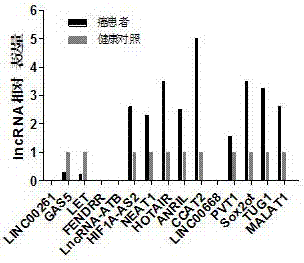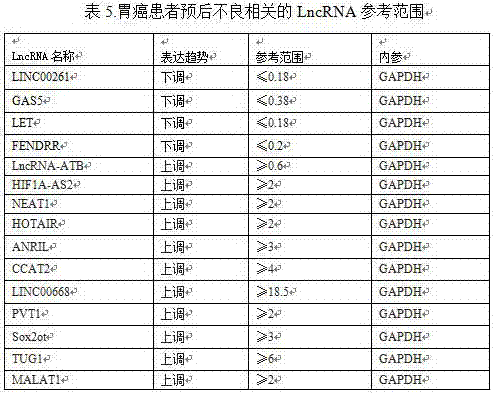LncRNA combination for detecting prognosis condition of stomach cancer and kit containing combination
A kit and gastric cancer technology, applied in the field of biomedicine, can solve the problems of inability to reflect the overall situation of patients, incomplete diagnosis and treatment of gastric cancer, and incomplete understanding of disease progression, so as to improve the evaluation of prognosis, avoid detection errors, and improve accuracy. sexual effect
- Summary
- Abstract
- Description
- Claims
- Application Information
AI Technical Summary
Problems solved by technology
Method used
Image
Examples
Embodiment 1
[0060] RT-qPCR technology was used to detect the differential expression of lncRNA combinations in gastric cancer tissues and paired normal gastric mucosal tissues: 1. The total RNA of gastric cancer tissues and corresponding paracancerous tissues was extracted by nucleic acid purification column
[0061] Pretreatment: In a clean area with less RNase interference (all utensils are wiped with 1‰ DEPC water), the mortar needs to be sterilized at 200°C for 5 hours and cooled for 4 hours.
[0062] 2. Tissue Lysis:
[0063] 1) Weigh about 20 mg of isolated gastric cancer tissue and para-cancerous tissue samples into a mortar that has been poured with liquid nitrogen and pre-cooled, and grind to powder with a grinding rod (incomplete grinding will seriously affect the yield of RNA ); 2) Add 700μl QIAzol lysate to the mortar, continue to grind to a homogeneous liquid without obvious tissue pieces, and then transfer to a 1.5ml eppendorf tube without RNase; 3) Centrifuge in a refrigera...
Embodiment 2
[0078] Example 2. Using RT-qPCR technology to detect the differential expression of lncRNA combinations in gastric cancer patient serum and healthy controls:
[0079] 1. Serum RNA is extracted The present invention adopts centrifugal column type RNA rapid extraction kit to extract, and concrete steps are as follows:
[0080] 1) Take 0.25ml of serum, add 0.75ml of Lysis Buffer RLS, shake the homogenate sample vigorously, and incubate at 15-30°C for 5 minutes to completely decompose the protein body;
[0081] 2) Centrifuge at 12000rpm for 10min at 4°C, carefully take the supernatant and transfer it to a new RNase free centrifuge tube;
[0082] 3) Add 0.15ml chloroform, cover the sample tube tightly, shake vigorously for 15s and incubate at room temperature for 3min;
[0083] 4) Centrifuge at 4°C and 12000rpm for 10min, the sample will be divided into three layers: the lower layer is the organic phase, the middle layer and the upper layer are colorless aqueous phases, RNA exists...
PUM
 Login to View More
Login to View More Abstract
Description
Claims
Application Information
 Login to View More
Login to View More - R&D
- Intellectual Property
- Life Sciences
- Materials
- Tech Scout
- Unparalleled Data Quality
- Higher Quality Content
- 60% Fewer Hallucinations
Browse by: Latest US Patents, China's latest patents, Technical Efficacy Thesaurus, Application Domain, Technology Topic, Popular Technical Reports.
© 2025 PatSnap. All rights reserved.Legal|Privacy policy|Modern Slavery Act Transparency Statement|Sitemap|About US| Contact US: help@patsnap.com



